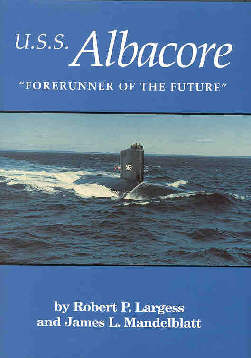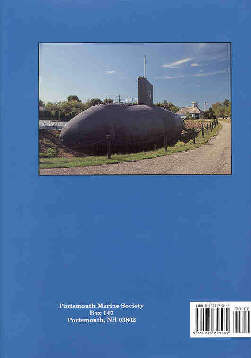|
USS Albacore - Forerunner of the Future |
| Today, the USS
Albacore (AGSS - 569) sits on dry land in Portsmouth, New Hampshire. She
serves there as a memorial to the US Navy's submarine service, to the
workers of the Portsmouth Naval Shipyard who built so many of its boats,
and in particular to the Navymen, scientists and engineers who created
the Navy's postwar nuclear submarine fleet, and changed the nature of
naval warfare forever.
Prof. Gary Weir has called the Albacore "the most significant submarine ever built"; yet she is not nuclear. Few people know much about her, other than her perfectly streamlined "teardrop" hull, and her fantastic speed - she broke the world's submerged speed record twice in her career, and remains faster than all our nukes until, perhaps, the Seawolf. (Click images for larger view) But the real purpose behind her building was not so much to achieve this speed but to learn how to control a submerged sub at destroyer speeds. The absolute maximum submerged speeds before her were perhaps 15 knots. Taking a sub with a test depth of 600 ft to speeds of 27, 30 even 35 knots, was, as her skipperBill St. Lawrence put it, "like flying a plane at Mach 2 and 1000 ft - one blink and you're in the ground." Albacore was the first submarine able to maneuver freely in three dimensions, like an airplane. She was taken to her limits (and beyond) to establish the "flight profile" for the streamlined nuclear submarine. The process was often hair-raising; it was made possible by the fact that she was a "mere" diesel boat, free from Adm. Rickover's caution and stringent control over the nuclear fleet. In the process, she tested out practically every technological advance incorporated in the nuclear submarine fleet, hull and control surface configuration, bow and towed sonars, emergency ballast blow, aircraft-style controls and control room instrumentation - everything but nuclear power itself. Indeed, she tested many strange items of technology never adopted by the fleet. In the course of nearly 20 years service, she was taken apart four times and rebuilt with a series of stern control surfaces and contra-rotating props. This story is based largely on interviews with her early proponents, her designer, Capt. Harry Jackson, her skippers, crewmen, yard workers, scientists and engineers who tended and nursed her through two decades of remarkable experiments. It is told largely in their own words. As Bob Johnson of PNS, instrumental in the effort to save the Albacore as a memorial, once remarked: "It's a strange thing how a ship is alive, a living organism, so many complicated things going on when the crew is aboard. All the human feelings blend in to create a mind or spirit of her own. Then they walk off, and she's just iron. " The goal of this book is not only to tell the story and explain the significance of a ship, but to make the living organism of the Albacore live again in the reader's mind. |

